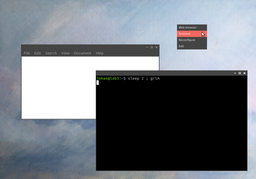labwc stands for Lab Wayland Compositor, where lab can mean any of the following:
- sense of experimentation and treading new ground
- inspired by BunsenLabs and ArchLabs
- your favorite pet
It is a wlroots-based stacking compositor aiming to be lightweight and independent, with a focus on simply stacking windows well and rendering some window decorations. It relies on clients for wallpaper, panels, screenshots, and so on to create a full desktop environment.
Labwc tries to stay in keeping with wlroots and sway in terms of general approach and coding style.
In order to avoid reinventing configuration and theme syntax, the openbox-3.4 specification is used. This does not mean that labwc is an openbox clone but rather that configuration files will look and feel familiar.
| video link | date | content |
|---|---|---|
| Video (0:18) | 16-Oct-2021 | SnapToEdge feature |
| Video (1:10) | 05-Aug-2021 | window gymnastics, theming and waybar |
| Video (3:42) | 25-Feb-2021 | setting background and themes; xwayland/xdg-shell windows |

So far, labwc supports the following:
- Config files (rc.xml, autostart, environment)
- Theme files and xbm icons
- Damage tracking to reduce CPU usage
- A basic root-menu (configured with menu.xml)
- HiDPI
- wlr-output-management protocol
- layer-shell protocol
- foreign-toplevel protocol (e.g. to integrate with panels and bars)
- Optionally xwayland
meson build/
ninja -C build/
Dependencies include:
- meson, ninja, gcc/clang
- wlroots (master)
- wayland (>=1.19)
- wayland-protocols
- libinput (>=1.14)
- libxml2
- cairo, pango, glib-2.0
- xkbcommon
- xwayland, xcb (optional)
Disable xwayland with meson -Dxwayland=disabled build/
For further details see wiki/Build.
See wiki/Install.
Labwc uses the files listed below for configuration and theming.
| file | user over-ride location | man page |
|---|---|---|
| rc.xml | ~/.config/labwc/ | labwc-config(5), labwc-actions(5) |
| menu.xml | ~/.config/labwc/ | labwc-menu(5) |
| autostart | ~/.config/labwc/ | labwc(1) |
| environment | ~/.config/labwc/ | labwc-environment(5) |
| themerc | ~/.local/share/themes/<theme-name>/openbox-3/ | labwc-theme(5) |
The example rc.xml has been kept simple. For all options and default values, see rc.xml.all
Configuration and theme files are reloaded on receiving SIGHUP (e.g. killall -SIGHUP labwc)
For keyboard settings, see environment and xkeyboard-config(7)
For themes, search the internet for "openbox themes" and place them in ~/.local/share/themes/. Some good starting points include:
- https://github.com/addy-dclxvi/openbox-theme-collections
- https://github.com/the-zero885/Lubuntu-Arc-Round-Openbox-Theme
- https://bitbucket.org/archlabslinux/themes/
- https://github.com/BunsenLabs/bunsen-themes
./build/labwc [-s <command>]
Click on the background to launch a menu.
If you have not created an rc.xml config file, default bindings will be:
| combination | action |
|---|---|
alt-tab |
activate next window |
alt-escape |
exit |
super-return |
alacritty |
alt-F3 |
bemenu |
alt-F4 |
close window |
super-a |
toggle maximize |
alt-mouse-left |
move window |
alt-mouse-right |
resize window |
alt-arrow |
move window to edge |
super-arrow |
resize window to fill half the output |
XF86_AudioLowerVolume |
amixer sset Master 5%- |
XF86_AudioRaiseVolume |
amixer sset Master 5%+ |
XF86_AudioMute |
amixer sset Master toggle |
XF86_MonBrightnessUp |
brightnessctl set +10% |
XF86_MonBrightnessDown |
brightnessctl set 10%- |
Suggested apps to use with labwc:
- Screen shooter: grim
- Screen recorder: wf-recorder
- Background image: swaybg
- Panel: waybar, yambar, lavalauncher
- Launchers: bemenu, fuzzel, wofi
- Output managers: kanshi, wlr-randr
- Screen locker: swaylock
A lot of emphasis is put on code simplicity when considering features.
The main development effort is focused on producing a solid foundation for a stacking compositor rather than adding configuration and theming options.
See acceptance criteria for details.
High-level summary of items which are not intended to be implemented:
- Icons (except window buttons)
- Animations
- Gradients for decoration and menus
- Any theme option not required to reasonably render common themes (it's amazing how few options are actually required).